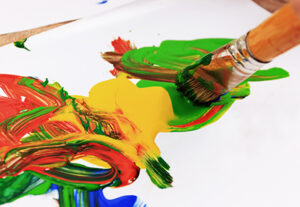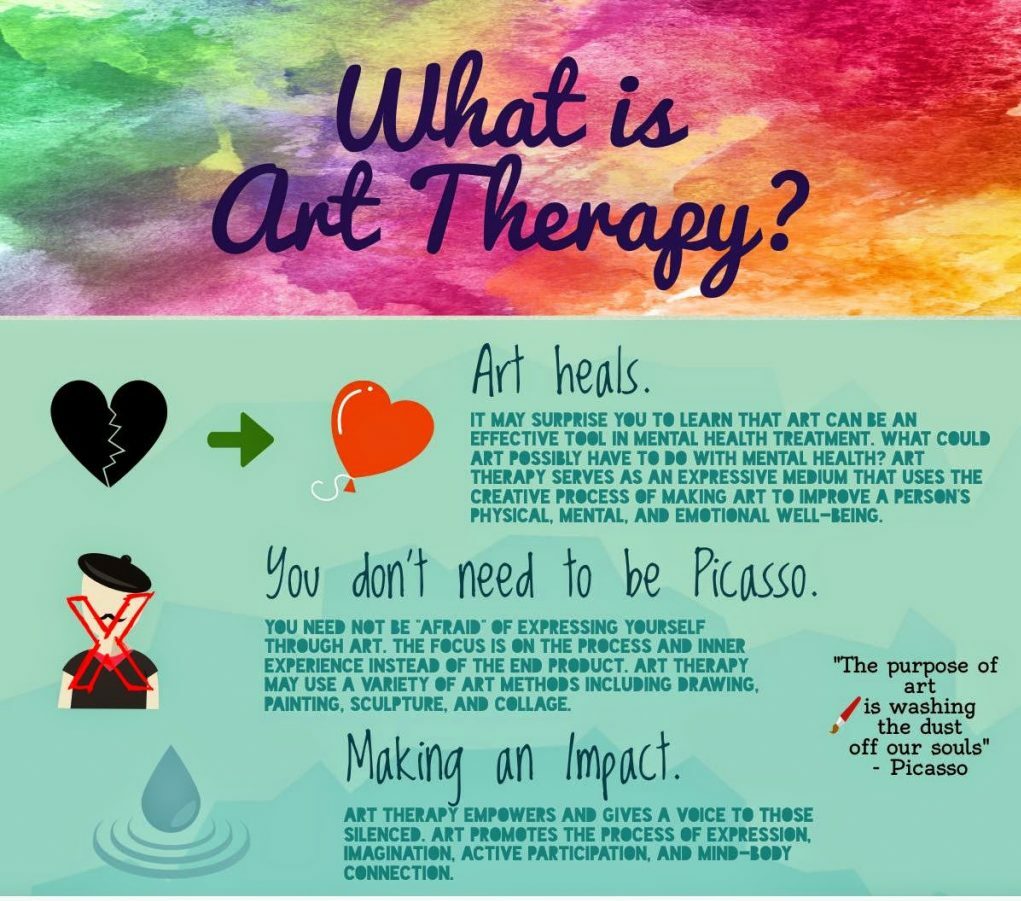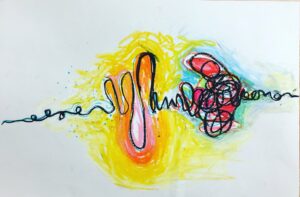Thoughts of what to paint swirl around in my head like a tornado. I feel the brush in my hand before the paint even touches the canvas. And I am one with art. It feels I am in control. This is how it feels for me when I’m in the zone, creating artwork through art therapy.
In this blog post, we’ll explore the concept of art therapy, how it works, and the evaluation of this type of therapy. We’ll also touch on who can benefit from this therapy and some case studies to give you a better understanding of what art as therapy is all about.
Contents
Understanding Art Therapy

The American Art Therapy Association defines art therapy as “an integrative mental health profession that uses the creative process of art-making to improve and enhance the physical, mental, and emotional well-being of individuals of all ages.
It is based on the belief that the creative process involved in artistic self-expression helps people to resolve conflicts and problems, develop interpersonal skills, manage behavior, reduce stress, increase self-esteem and self-awareness, and achieve insight.”
In other words, this therapy is about using the creative process to help people heal emotionally and mentally. Art therapists are trained in both art and therapy. It means they know how to use different art mediums to help people express themselves. They also know how to provide support and guidance to their clients.
Expressive Therapy Vs. Art Therapy
There is some overlap between expressive therapy and art therapy, but there are also some key differences.
- The former uses creative expression as a way to explore feelings and emotions. It can be used in combination with other therapies, such as counseling or psychotherapy.
- The latter, on the other hand, is a specific type of therapy that uses the creative process to help people heal emotionally and mentally. It is based on the belief that the creative process can help resolve conflicts and problems.
Theory Behind Art Therapy
There are several theories behind why this therapy might be helpful.
- One theory suggests that when we create artwork, we are tapping into our subconscious. This can allow us to access thoughts and feelings that we might not be able to express in words.
- Another theory suggests that the act of creating artwork can help us to process difficult experiences, emotions, and memories.
History And Development
Art therapy has been around for a long time, but it only became recognized as a formal profession in the mid-20th century.
One of the earliest pioneers in this therapy was Margaret Naumburg. She wrote about using art to treat mental illness in her book, Psychotherapy Through Art (1936).
Since then, this therapy has been used to help people with a wide range of issues, including anxiety, depression, trauma, and addiction.
Contributions Made To Art Therapy
Since its inception, art therapy has evolved and changed. Early pioneers in the field made important contributions that have shaped how this therapy is practiced today.
Some of these early contributors include Margaret Naumburg, Edith Kramer, and Carl Rogers. They helped to establish art therapy as a profession and developed different theories about how and why it might be helpful.
Current Trends
Art therapy is constantly evolving. New research is helping to shed light on how this therapy can be used to effectively treat different issues.
Some current trends in art therapy include using art to manage stress, using technology in this therapy, and using art to promote wellness.
Unfolding Art Therapy

Art therapy is a fairly new profession, which means it’s still unfolding. This means that there is still much to learn about how this therapy works and who it can help.
One of the things that make this therapy so unique is that it can be adapted to meet the needs of each client.
This means that art therapists can use a variety of techniques and mediums depending on what will be most helpful for the person they are working with.
Who Can It Help
This therapy can be helpful for people of all ages.
- It can be used to treat a wide range of issues, including anxiety, depression, trauma, and addiction.
- Art therapy is also often used with children who have autism or other developmental disabilities.
- It can also be used to help children process difficult experiences, emotions, and memories.
How Does It Work
There is no one-size-fits-all answer to this question. The way that this therapy works will vary depending on the individual. And the type of therapy they are receiving. This can happen in several ways.
For example, creating artwork can help people to process difficult experiences, emotions, and memories. It can also allow people to access thoughts and feelings that they might not be able to express in words.
Additionally, this therapy provides a supportive environment where people can explore their creativity and connect with others.
However, in general, this therapy can help people to:
- Express themselves creatively
- Process difficult experiences and emotions
- Increase self-awareness
- Reduce stress and anxiety
- Gain insight into their thoughts and feelings
Techniques Used
Many different techniques can be used in this therapy. The type of technique that is used will depend on the individual and the type of issue they are dealing with.
Some common techniques include:
- Drawing
- Painting
- Sculpting
- Collage
- Journaling
- Photography
There are several different techniques that art therapists might use in their work. Therapists might also ask clients to keep journals or participate in creative exercises.
Evaluating Art Therapy

Art therapy is a relatively new profession, which means there is still much to learn about how it works.
That said, some research suggests this therapy can be helpful for people with mental health issues. For example:
- One study found that this therapy was effective in reducing anxiety and depression in adults with cancer.
- Another study found that this therapy was helpful for children who had experienced trauma.
Benefits
There are many benefits to this therapy. However, some of the key benefits include:
- Reduced stress and anxiety
- Improved mental health
- Enhanced self-awareness
- Increased creativity
- Greater insight into thoughts and feelings
- Improved communication skills.
Limitations
This therapy may not a perfect solution for everyone. There are some limitations to consider, such as:
- It is not always covered by insurance
- It may not be available in all areas
- Finding an art therapist can be difficult
- Not everyone is comfortable with the idea of using art as therapy
Why Consider It
Despite its limitations, art therapy is a promising field. If you are struggling with mental health issues, it may be worth considering.
Keep This In Mind
If you are considering this therapy, there are several things to keep in mind.
- First, make sure you understand what to expect from the therapy.
- Second, be prepared to commit to the process.
- Lastly, be patient – it may take some time to see results.
Finding an Art Therapist

If you have an interest in trying art as therapy, the first step is finding a qualified and licensed therapist.
There are several ways to find an art therapist:
- The American Art Therapy Association (AATA) has a directory of certified art therapists.
- Your health insurance company may have a list of providers who offer art therapy.
- You can search for therapists in your area by zip code or city.
Types of Art Therapists
There are two main types of art therapists: clinical and non-clinical.
- Clinical art therapists: They work in hospitals, clinics, or private practice. They have a degree in art therapy and have a license to provide mental health services.
- Non-clinical art therapists: They do not have a degree in art therapy. They may work in schools, community centers, or senior centers.
What To Look Out For
When looking for an art therapist, there are a few things to look out for.
- First, make sure the therapist has a license and has certification by AATA.
- Second, be sure to ask about their experience and training in art therapy.
- Third, find out what the therapist’s approach is and how they will work with you.
- Lastly, ask if the therapist has any fees.
Red Flags To Avoid
There are also a few red flags to avoid when looking for an art therapist.
- First, be wary of therapists who promise miraculous results.
- Second, beware of therapists who push you to create art that is dark or depressing.
- Third, avoid therapists who are pushy or do not respect your boundaries.
- Forth, be cautious of therapists who want you to share personal information about your life without getting to know you first.
- Fifth, stay away from therapists who use offensive language or make you feel uncomfortable.
Pursuing Training In Art Therapy
If you have an interest in pursuing training in art therapy, there are a few things to keep in mind.
- First, make sure you choose an accredited program.
- Second, consider your career goals and what type of therapist you want to be.
- Third, be prepared to commit time and energy to the program.
- Lastly, be patient – it takes time to become a certified art therapist.
Hearing From Experts

If you are considering this therapy, it can be helpful to hear from experts in the field. Here is what some of them have to say:
“Art therapy is a unique form of psychotherapy that uses art media as its primary mode of communication. It involves the use of art materials in a therapeutic process that is facilitated by the art therapist. The therapist uses the creative process to help clients explore their emotions, increase self-awareness, and achieve personal insight.” – Cathy Malchiodi, Ph.D., ATR-BC, LPAT, LPCC
“Art therapy is an effective treatment for a wide variety of mental health issues. It can be used to treat anxiety, depression, trauma, and more. Art therapy is a unique form of therapy that can help people in ways that other therapies cannot.” – Amy Krakowiak, MA, ATR-BC
Case Study
Sarah is a 20-year-old college student who has been struggling with anxiety and depression for the past year. She decided to try art therapy and found that it helped manage her mental health.
Sarah attended sessions regularly and did the homework that her therapist assigned. She found that using art as therapy allowed her to express herself in a way that she couldn’t do with words. It also helped her to better understand her thoughts and emotions.
After a few months of therapy, Sarah began to feel better. She had less anxiety and was able to cope with her depression healthily.
Resources

If you have an interest in learning more about this therapy, consider the following resources:
- The American Art Therapy Association: This website provides information about art therapy, including how to find a therapist in your area.
- Art Therapy: This website provides an overview of art therapy and how it can help treat mental health issues.
Conclusion
Art therapy is a powerful tool that can help people of all ages heal from a variety of mental health issues. It may take some time to see results, but it is worth considering if you are struggling with mental health issues.
A Word From Therapy Mantra
Your mental health — Your psychological, emotional, and social well-being — has an impact on every aspect of your life. Positive mental health essentially allows you to effectively deal with life’s everyday challenges.
At TherapyMantra, we have a team of therapists who provide affordable online therapy to assist you with issues such as depression, anxiety, stress, workplace Issues, addiction, relationship, OCD, LGBTQ, and PTSD. You can book a free therapy or download our free Android or iOS app.


